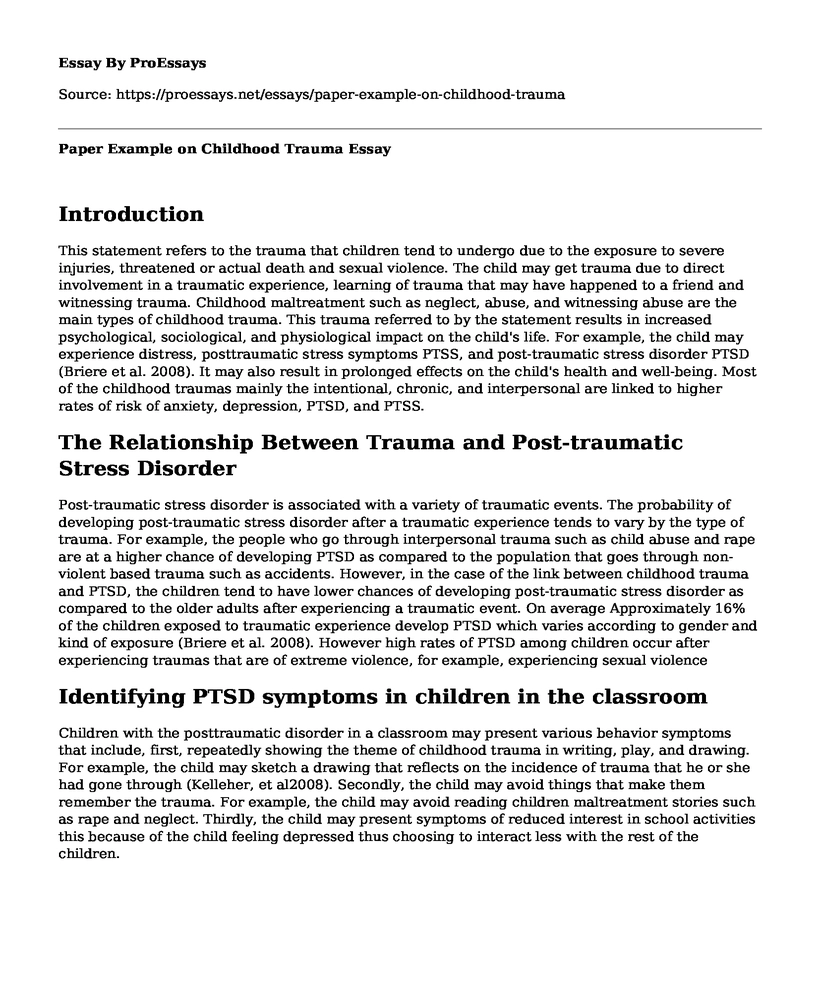Introduction
This statement refers to the trauma that children tend to undergo due to the exposure to severe injuries, threatened or actual death and sexual violence. The child may get trauma due to direct involvement in a traumatic experience, learning of trauma that may have happened to a friend and witnessing trauma. Childhood maltreatment such as neglect, abuse, and witnessing abuse are the main types of childhood trauma. This trauma referred to by the statement results in increased psychological, sociological, and physiological impact on the child's life. For example, the child may experience distress, posttraumatic stress symptoms PTSS, and post-traumatic stress disorder PTSD (Briere et al. 2008). It may also result in prolonged effects on the child's health and well-being. Most of the childhood traumas mainly the intentional, chronic, and interpersonal are linked to higher rates of risk of anxiety, depression, PTSD, and PTSS.
The Relationship Between Trauma and Post-traumatic Stress Disorder
Post-traumatic stress disorder is associated with a variety of traumatic events. The probability of developing post-traumatic stress disorder after a traumatic experience tends to vary by the type of trauma. For example, the people who go through interpersonal trauma such as child abuse and rape are at a higher chance of developing PTSD as compared to the population that goes through non-violent based trauma such as accidents. However, in the case of the link between childhood trauma and PTSD, the children tend to have lower chances of developing post-traumatic stress disorder as compared to the older adults after experiencing a traumatic event. On average Approximately 16% of the children exposed to traumatic experience develop PTSD which varies according to gender and kind of exposure (Briere et al. 2008). However high rates of PTSD among children occur after experiencing traumas that are of extreme violence, for example, experiencing sexual violence
Identifying PTSD symptoms in children in the classroom
Children with the posttraumatic disorder in a classroom may present various behavior symptoms that include, first, repeatedly showing the theme of childhood trauma in writing, play, and drawing. For example, the child may sketch a drawing that reflects on the incidence of trauma that he or she had gone through (Kelleher, et al2008). Secondly, the child may avoid things that make them remember the trauma. For example, the child may avoid reading children maltreatment stories such as rape and neglect. Thirdly, the child may present symptoms of reduced interest in school activities this because of the child feeling depressed thus choosing to interact less with the rest of the children.
References
Briere, J., Kaltman, S., & Green, B. L. (2008). Accumulated childhood trauma and symptom complexity. Journal of Traumatic Stress: Official Publication of The International Society for Traumatic Stress Studies, 21(2), 223-226.
Kelleher, I., Harley, M., Lynch, F., Arseneault, L., Fitzpatrick, C., & Cannon, M. (2008). Associations between childhood trauma, bullying and psychotic symptoms among a school-based adolescent sample. The British Journal of Psychiatry, 193(5), 378-382.
Cite this page
Paper Example on Childhood Trauma. (2022, Jul 29). Retrieved from https://proessays.net/essays/paper-example-on-childhood-trauma
If you are the original author of this essay and no longer wish to have it published on the ProEssays website, please click below to request its removal:
- Women in Sports Before and After 1970 Essay
- Nobel Prize Gender Gap: Only 48 Women Laureates in 119 Years - Essay Sample
- Feminism: The Unifying Fight for Gender Equality Across the World - Research Paper
- Drug Use: Impact on Individuals & Society - Essay Sample
- Essay Example on the Dark Realities of Racial Prejudice & Discrimination in U.S.A.
- Essay on ACT Improves Long-Term Outcomes of Drug-Dependent Female Inmates
- Romantic Story: Rush - Free Paper Sample







